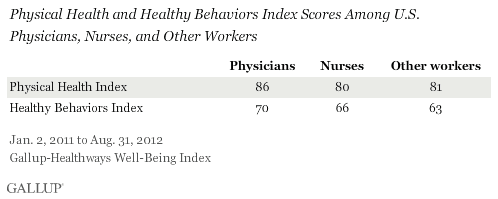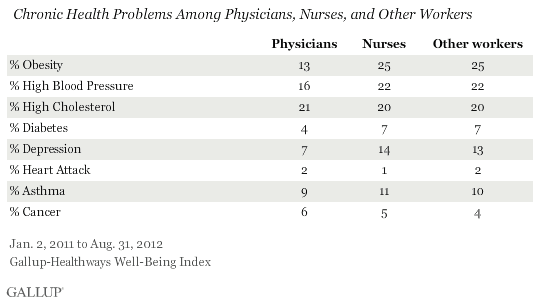WASHINGTON, D.C. -- Physicians in the United States are in better health and have better health habits compared with nurses and the employed adult population, suggesting Americans should do more than take advice from their physicians -- they can also look to them as an example for healthy living. Physicians score better on the Gallup-Healthways Physical Health Index and Healthy Behaviors Index.

These data, collected as part of the Gallup-Healthways Well-Being Index, encompass interviews with 1,984 physicians and 7,166 nurses, conducted Jan. 2, 2011 to Aug. 31, 2012. The Physical Health Index includes 18 items, which measure the number sick days in the past month, disease burden, health problems that get in the way of normal activities, obesity, feeling well-rested, daily energy, daily colds, daily flu, and daily headaches. The Healthy Behavior Index includes four items: smoking, eating healthy, weekly consumption of fruits and vegetables, and weekly exercise frequency.
The differences in the index scores between physicians and the rest of the employed population hold true after controlling for income. The Physical Health Index differences between physicians and the rest of the employed population also hold true after controlling for education, however, the Healthy Behavior Index differences do not. Holding education levels constant, physicians score on par with the rest of the adult employed population, indicating that it is education broadly, not being a physician per se, that plays a role in one's health habits.
Physicians Make Healthier Choices
Physicians are less likely to smoke and are more likely to eat healthy and exercise frequently than are nurses and the employed adult population. Less than 5% of physicians smoke compared with 15% of nurses and 20% of other workers.
Fifty-eight percent of physicians exercise three or more days per week, more than the 54% of adults in the rest of the employed population who do the same. Physicians are also more likely than those in the employed adult population to say they ate healthy all day "yesterday" and to report eating a healthy amount of fruits and vegetables.

After controlling for education, physicians only outperform nurses and other workers in terms of smoking -- those who are highly educated in each group are equally likely to exercise and eat healthy.
Physicians Less Likely to Be Obese, Report Fewer Chronic Health Problems
Physicians are much less likely than nurses and other adult workers to be obese -- 13% vs. 25%. Likely related to their healthier weight, physicians are also significantly less likely than employed adults in general to say they have ever been diagnosed with high blood pressure or diabetes -- two conditions linked to obesity. However, physicians are as likely as others to have high cholesterol and to have had a heart attack.

Cancer is the one health metric that physicians are more likely than other adults to report. Whether this reflects environmental and lifestyle factors unique to doctors, doctors' greater awareness of the warning signs, or a higher vigilance on their part about getting screened, is unclear.
Bottom Line
Physicians report having better physical health and health habits than either nurses or other workers. This partly reflects higher-educated Americans' performance on these measures more broadly; nevertheless, physicians set a good example for their patients. As primary healthcare providers, physicians play an important role in helping others understand how to lead healthy lives. Thus, the fact they are in relatively good shape reveals that most of them are well-positioned to teach their patients how to maintain a healthy weight and reduce their risk for chronic disease.
As the United States continues to deal with high levels of obesity and related chronic conditions, it faces significant health and financial difficulties -- putting a substantial strain on the healthcare system. According to the U.S. Preventive Services Task Force (USPSTF), "obesity is associated with such health problems as an increased risk for coronary heart disease, type 2 diabetes mellitus, various types of cancer, gallstones, and disability," which leads to higher use of healthcare services and greater costs. USPSTF now recommends that physicians screen all adults for obesity. These new guidelines increase physicians' responsibility to ensure that their patients are maintaining a healthy weight and healthy habits, making it even more important for physicians to continue setting a good example.
Survey Methods
Results are based on telephone interviews conducted as part of the Gallup Healthways Well-Being Index survey Jan. 2, 2011-Aug. 31, 2012, with a random sample of 591,821 adults, aged 18 and older, living in all 50 U.S. states and the District of Columbia.
For results based on the total sample of national adults, one can say with 95% confidence that the maximum margin of sampling error is ±1 percentage points.
For results based on the total sample of physicians, one can say with 95% confidence that the maximum margin of sampling error is ±3 percentage points.
For results based on the total sample of nurses, one can say with 95% confidence that the maximum margin of sampling error is ±1 percentage points.
For results based on the total sample of employed non-physicians and non-nurses, one can say with 95% confidence that the maximum margin of sampling error is ±1 percentage points.
Interviews are conducted with respondents on landline telephones and cellular phones, with interviews conducted in Spanish for respondents who are primarily Spanish-speaking. Each sample includes a minimum quota of 400 cell phone respondents and 600 landline respondents per 1,000 national adults, with additional minimum quotas among landline respondents by region. Landline telephone numbers are chosen at random among listed telephone numbers. Cell phones numbers are selected using random digit dial methods. Landline respondents are chosen at random within each household on the basis of which member had the most recent birthday.
Samples are weighted by gender, age, race, Hispanic ethnicity, education, region, adults in the household, and phone status (cell phone-only/landline only/both, cell phone mostly, and having an unlisted landline number). Demographic weighting targets are based on the March 2011 Current Population Survey figures for the aged 18 and older non-institutionalized population living in U.S. telephone households. All reported margins of sampling error include the computed design effects for weighting and sample design.
In addition to sampling error, question wording and practical difficulties in conducting surveys can introduce error or bias into the findings of public opinion polls.
For more details on Gallup's polling methodology, visit https://www.gallup.com/.
